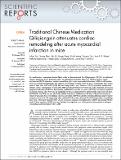Traditional Chinese Medication Qiliqiangxin attenuates cardiac remodeling after acute myocardial infarction in mice

View/
Author
Tao, Lichan
Shen, Sutong
Fu, Siyi
Fang, Hongyi
Wang, Xiuzhi
Sluijter, Joost P. G.
Zhou, Yonglan
Kong, Xiangqing
Xiao, Junjie
Li, Xinli
Note: Order does not necessarily reflect citation order of authors.
Published Version
https://doi.org/10.1038/srep08374Metadata
Show full item recordCitation
Tao, L., S. Shen, S. Fu, H. Fang, X. Wang, S. Das, J. P. G. Sluijter, et al. 2015. “Traditional Chinese Medication Qiliqiangxin attenuates cardiac remodeling after acute myocardial infarction in mice.” Scientific Reports 5 (1): 8374. doi:10.1038/srep08374. http://dx.doi.org/10.1038/srep08374.Abstract
In a multicenter randomized double-blind study we demonstrated that Qiliqiangxin (QLQX), a traditional Chinese medicine, had a protective effect in heart failure patients. However, whether and via which mechanism QLQX attenuates cardiac remodeling after acute myocardial infarction (AMI) is still unclear. AMI was created by ligating the left anterior descending coronary artery in mice. Treating the mice in the initial 3 days after AMI with QLQX did not change infarct size. However, QLQX treatment ameliorated adverse cardiac remodeling 3 weeks after AMI including better preservation of cardiac function, decreased apoptosis and reduced fibrosis. Peroxisome proliferator-activated receptor-γ (PPARγ) was down-regulated in control animals after AMI and up-regulated by QLQX administration. Interestingly, expression of AKT, SAPK/JNK, and ERK was not altered by QLQX treatment. Inhibition of PPARγ reduced the beneficial effects of QLQX in AMI remodeling, whereas activation of PPARγ failed to provide additional improvement in the presence of QLQX, suggesting a key role for PPARγ in the effects of QLQX during cardiac remodeling after AMI. This study indicates that QLQX attenuates cardiac remodeling after AMI by increasing PPARγ levels. Taken together, QLQX warrants further investigation as as a therapeutic intervention to mitigate remodeling and heart failure after AMI.Other Sources
http://www.ncbi.nlm.nih.gov/pmc/articles/PMC4648480/pdf/Terms of Use
This article is made available under the terms and conditions applicable to Other Posted Material, as set forth at http://nrs.harvard.edu/urn-3:HUL.InstRepos:dash.current.terms-of-use#LAACitable link to this page
http://nrs.harvard.edu/urn-3:HUL.InstRepos:23845186
Collections
- HMS Scholarly Articles [17920]
Contact administrator regarding this item (to report mistakes or request changes)


